 GH found a wonderful painting at a thrift store and sent me a photo. He’s such a genius, because he thinks it may look like a dream, and indeed it DOES. Not in American or European art, but in a very different culture. He wonders if this painting conveys a message from an artist about the world of their dreams? YES.
GH found a wonderful painting at a thrift store and sent me a photo. He’s such a genius, because he thinks it may look like a dream, and indeed it DOES. Not in American or European art, but in a very different culture. He wonders if this painting conveys a message from an artist about the world of their dreams? YES.
The definition of “dream painting” depends on what you consider a dream reality to be, and what a two dimension image of something we call a painting should portray if it’s ABOUT a dream. See how I love to think about GH’s painting?
I find these questions SO interesting. Turns out various cultures define both DREAM and ART in various ways.
Dream Painting Questions Reality
I started my search to help GH to find the origin by googling “dream paintings.” I got a brilliant article, but very European focused, citing the “Debt Dreams Owe to Art in Dreams and Nightmares.” Well, you guessed it, the illustrations of this article came from paintings by Hieronymus Bosch, specifically “The Garden pf Earthly Delights.” 15th century scholars said perhaps Bosch envisioned Heaven and or Hell, or maybe he wasn’t interested in that literalism. Maybe he understood and painted the European realistic language of illustration art, and he did that SO fantastically, to make us question reality.
But I notice that GH’s painting is NOT European, it’s Australian, and specifically Aboriginal Australian. For that definition there’s no dividing line between WHAT art IS, and what is TRUE, and what is NOT in visual imagery. In certain traditions art isn’t thought of as true, or not. It’s thought of as utilitarian, a means to an end. Art therefore is not held up as separate from reality at all, and therefore not associated with the abstraction in literal portrayals, such as European realistic paintings.
But occasionally abstraction is closer to the reality of dreams. In the case of GH’s work of aboriginal art, this work is not about the abstraction of dreams, it’s about the reality of dreaming EACH NIGHT. We all do that, and as we know from REM sleep experiences, DREAMING is all time based.
I love that this painting measures time with DOTS. The (unsigned) artist, and many aboriginal artists, are brilliant at suggesting time, and dreams both.
I also love the symbol of DOTS.
Like all punctuation the dots make sense because they’re the time-makers of an experience of a dream. Because this is a dream painting we sense the artist interprets their dream in a narrative, dot after dot, punctuation after punctuation, time-based, narrative experience. The images the person dreams about aren’t painted, but the time sequence of the images are definitely portrayed. What a novel way of marking the way the mind thinks whilst dreaming!
The glory of this painting, found for $10 in a thrift store, is NOT the portrayal of realism as WE think of it, but the portrayal of ANOTHER KIND of realism. The meaning comes out of a personal story, unknown to others, but punctuated. If you think of the swirls and dots as markers along the axis of a dream, you get my meaning. I know a few major collectors here in Santa Barbara of this art form, which is close to abstract European Abstract Expressionism, but SO different as well.
These Aboriginal Dream paintings at their BEST can be worth SIX figures. I say the quality of this is so GOOD that if GH researched the artist, I bet he’s looking at $8,000. Sotheby’s in Australia has a branch that can set an auction estimate on this if you contact them.
So happy to for the chance to see this wonderful piece! If anyone reading this collects these and recognizes the artist, please get in touch with me. I appreciate it for GH, who got lucky and could recognize DREAMING in art.
Wonderful and thanks so much for sharing!!